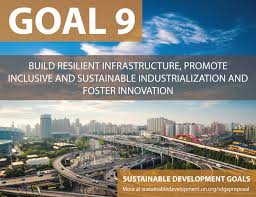Goal 9: Industry, Innovation, and Infrastructure
Goal 9 of the United Nations Sustainable Development Goals focuses on building resilient infrastructure, promoting inclusive and sustainable industrialization, and fostering innovation. This goal recognises the crucial role that infrastructure development and technological progress play in driving economic growth and improving quality of life.
Key Aspects of Goal 9:
- Infrastructure Development: Goal 9 emphasises the importance of investing in sustainable infrastructure to support economic development. Access to reliable and resilient infrastructure, such as transportation systems, energy networks, and communication technologies, is essential for fostering economic growth and connectivity.
- Industrialization: Promoting inclusive and sustainable industrialization involves encouraging the growth of industries that are environmentally friendly, socially responsible, and technologically advanced. This can create job opportunities, stimulate innovation, and enhance productivity.
- Innovation: Goal 9 highlights the significance of fostering innovation in various sectors to drive sustainable development. Innovation plays a key role in addressing global challenges, such as climate change and resource scarcity, by developing new technologies and solutions.
The Importance of Goal 9:
Achieving Goal 9 is crucial for advancing sustainable development worldwide. By investing in infrastructure development, promoting industrialization that respects environmental limits, and fostering innovation across sectors, countries can create a foundation for long-term prosperity.
Challenges Ahead:
Despite progress in some areas, there are still challenges to overcome in achieving Goal 9. These may include inadequate infrastructure in certain regions, barriers to technology transfer, and gaps in access to essential services. Addressing these challenges requires coordinated efforts from governments, businesses, civil society organisations, and other stakeholders.
Conclusion:
Goal 9 represents a critical component of the global agenda for sustainable development. By prioritising industry, innovation, and infrastructure investments that are inclusive and sustainable, countries can pave the way for a more prosperous future for all.
Understanding Goal 9: Infrastructure, Industrialisation, and Innovation in the UN Sustainable Development Agenda
- What is Goal 9 of the United Nations Sustainable Development Goals?
- Why is infrastructure development considered crucial for economic growth?
- How does Goal 9 promote inclusive and sustainable industrialization?
- What role does innovation play in achieving Goal 9?
- What are the challenges faced in implementing Goal 9?
What is Goal 9 of the United Nations Sustainable Development Goals?
Goal 9 of the United Nations Sustainable Development Goals focuses on the development of resilient infrastructure, the promotion of inclusive and sustainable industrialization, and the fostering of innovation. This goal underscores the importance of investing in infrastructure that can withstand challenges, supporting industries that are environmentally responsible and socially inclusive, and driving technological advancements to address global issues. By prioritising Goal 9, countries aim to create a solid foundation for economic growth, job creation, and sustainable development while ensuring that progress is made in a way that benefits both present and future generations.
Why is infrastructure development considered crucial for economic growth?
Infrastructure development is considered crucial for economic growth due to its pivotal role in facilitating trade, connectivity, and productivity. Reliable infrastructure, including transportation networks, energy systems, and communication technologies, forms the backbone of a thriving economy by enabling the efficient movement of goods and people. By investing in infrastructure, countries can reduce transportation costs, improve access to markets, attract investment, and create job opportunities. Additionally, modern infrastructure enhances the overall quality of life for citizens by providing essential services such as clean water, sanitation, and healthcare. Ultimately, robust infrastructure development not only accelerates economic growth but also lays the foundation for sustainable development and prosperity.
How does Goal 9 promote inclusive and sustainable industrialization?
Goal 9 promotes inclusive and sustainable industrialization by emphasising the importance of creating industries that are environmentally friendly, socially responsible, and technologically advanced. By encouraging the growth of industries that consider the well-being of both people and the planet, Goal 9 aims to generate economic opportunities while minimising negative impacts on the environment. This approach not only fosters innovation and productivity but also ensures that industrial development benefits all segments of society, including vulnerable populations. Through policies that support inclusive and sustainable industrialization, Goal 9 seeks to create a more equitable and resilient economic landscape for present and future generations.
What role does innovation play in achieving Goal 9?
Innovation plays a pivotal role in achieving Goal 9 of the United Nations Sustainable Development Goals. By fostering creativity, research, and technological advancements, innovation drives progress in building resilient infrastructure, promoting sustainable industrialization, and enhancing connectivity. Innovative solutions can help address challenges such as resource scarcity, environmental degradation, and inefficient systems by introducing new technologies and approaches that are more efficient, cost-effective, and environmentally friendly. Embracing innovation in various sectors is essential for unlocking opportunities for economic growth, job creation, and overall sustainable development in line with Goal 9’s objectives.
What are the challenges faced in implementing Goal 9?
Implementing Goal 9, which focuses on industry, innovation, and infrastructure, presents various challenges that need to be addressed. Some of the key obstacles include inadequate funding for infrastructure development, especially in less developed regions, limited access to technology and innovation resources for certain populations, and the need to balance industrial growth with environmental sustainability. Additionally, ensuring that industrialization is inclusive and benefits all segments of society can be a challenge, as disparities in access to opportunities and resources may exist. Overcoming these challenges requires coordinated efforts from governments, businesses, and communities to foster sustainable development practices that promote economic growth while safeguarding the environment and ensuring social equity.
